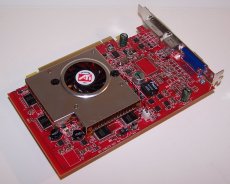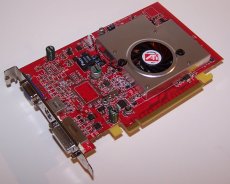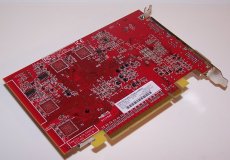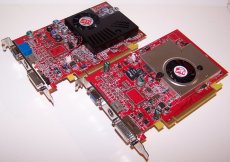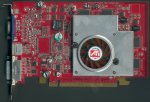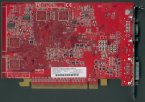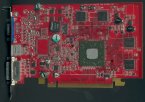Radeon X700 XT Board
The first of the two boards we're looking at here is a reference ATI Radeon X700 XT.
Whilst at the lower end of the X700 range there is only a 25MHz clock difference between the standard X700 and X700 PRO, there is a full 50MHz difference between the X700 XT and PRO, which appears to be pushing the clock speeds a little.
The board itself is a fairly uncomplicated affair with a size that's no bigger than the X600 / 9600 Radeon's. As these are presently PCI Express only boards there is no requirement for an extra power connector on the board as its power falls well within the 75Watts that PEG x16 can supply.
The board we have here is actually ATI's second revision board sent out for review and this board has a revised thermal system on it. The cooler comprises of a fat L-shaped copper base with copper fins soldered on at the two edges in order to increase surface area which the heat can be dissipated over. The fan itself has completely vertical fins in that pushes air directly across the fins, rather then down towards the base of the cooler.
During operation this particular board appeared to display no heat related issues, in fact generally it seemed to stay relatively cool during operation, however it achieves this by getting the fan to move plenty of air. As X700 is inevitably going to end up in mobile solutions the ASIC evidently has a thermal probe inbuilt and this is put to use for the controlling of fans speeds on this desktop version, with four operating fan speeds, dependant on core temperature. Curiously, the fan appears to hit top speed as soon as any 3D rendering occurs, it results in characteristics that are very reminiscent of NV30's FlowFX in terms of the sound produced and behaviour - while the fan certainly isn't as loud as NV30's, it is quite audible at top speed.
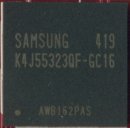
On the back plate of the board, there is ATI's usual display options of one DVI and one VGA port, with the TV-Out in-between. ATI had initially stated that the X700 boards are aimed at all round operations, inclusive of multimedia uses, however, in order to keep costs down again, this board doesn't have a Rage Theater on it for video-in as well as video-out, even though you can clearly see a space for it on the PCB for AIB's that may want to offer a configuration including it.

